The Buzzing of a Bee Priestess
I started writing a children's story last year about a little Bee named Lee. I am very concerned for humans, animals and Mother Earth if the number of bees keep disappearing. I can only hope for change, the story is about hope. I put down the project and now a year later decided to pick it up again and taking a completely different direction with it. I am super excited about the new adventures that I will create and experience myself in the creation. It is fun for me to sit and remind myself how a child sees the world. Also, learning from the experience not to take life too seriously.
We can learn so much from the Bees on a personal level and community. There is so much magic in the Bees. Did you know that Bees communicate through Dance? It is called the "waggle dance." I started belly dancing over six months ago, I feel connected to the Bees in the language of dance. The Bees are rich in Symbolism and mythology. I thought to myself is this the buzzing of a Bee Priestess? Did my calling come before and I did not recognize it until I had ripened myself? Did I have to ripen and bloom for the Bees to come share their magic with me?
The Bee Goddess Calls, by Judith Shaw
This article was posted more than a year ago since then new information regarding the Bees has come out. http://www.cbsnews.com/news/40-percent-of-u-s-bee-colonies-died-in-past-year/
Spring arrived in the Northern Hemisphere and all of Goddess’s children are waking up from our winter slumbers. Birds are singing, fruit trees are blossoming, bees are buzzing, and early spring bulb flowers are in full bloom. Signs of spring fever are evident as we find ourselves full of energy and vitality for new projects and relationships.
As new life emerges from the Earth we can more easily reflect on our place in the greater scheme of life. It’s a good time to question the values of our consumer society and ask if there is another way.
In contrast to these values of domination, separation, and consumption, ancient wisdom traditions teach that we are all connected – to each other, to all life, to the whole natural world and to the spiritual cosmos.
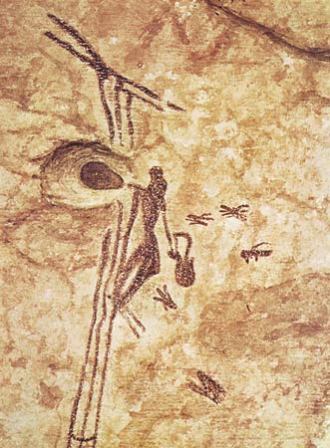
Woman gathering honey, watercolour copy by F. Benitez Mellado of a painting in the Cueva de la Arana, near Bicorp, Spain; the Museum of Prehistory, Valencia, Spain.
One canary in the coalmine that points out the lack of balance we have created with our industrial, military, consumer society is the disappearance and collapse of bee colonies all around the world. This is something that we ignore at our own peril. Without bees we could lose 30% of our food crops.
The relationship between humans and bees dates back to prehistoric days. Cave paintings found in Spain, from between 6000 and 80000 BC, depict our Neolithic ancestors gathering honey from wild bee colonies.
The earliest record of humans keeping bees in human made hives dates back to Egypt of 2400 BC.
The ancients believed that the bees’ ability to make honey was a gift from the divine. Bees who give us their sweet honey, used for food, drink and medicine have long been associated with Goddesses all around the world.
In ancient Egypt the main temple of the Goddess Neith was known as the “House of the Bee.” She was often depicted as a veiled Goddess which perhaps was an allusion to bees, often called hymenopterameaning “veil winged”. In truth the bees’ wings are beautiful lace-like fluttering veils.
The Greeks, who only knew how to collect wild honey, inherited bee keeping from the Minoans, who worked with and honored bees since the beginning of the Neolithic era. The Great Mother Goddess was often called “Melissa”, meaning “the Queen Bee" or Priestess. In the myth and imagery of both cultures, associations of the Mother Goddess with the little honeybee are abundant.
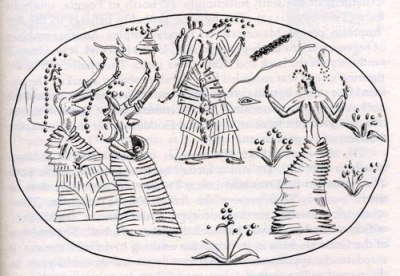
Gold ring depicting the Bee Goddess and Her devotees, the melissae, from the grave of Isopata near Knossos, Crete
India’s ancient sacred text, the Rig-Veda, contains numerous references to bees and honey. The Indian Bee Goddess, Bhramari Devi, whose name comes from the Hindi word bramari, meaning ‘bees’, is said to make Her home within the heart chakra. Here She emits the buzzing sound of Bees. All across ancient India the humming of bees represented the essential sound of the universe.
Bees are also sacred to the Celtic Goddess Brigid. The ancient Celts believed that Brigid’s bees brought their magical nectar to earth from her apple orchard in the Otherworld. Her power, manifesting through bees, endures through time. A Christianized version of Brigid, Gobnait, protected Her people with the help of bees. She thwarted a band of robbers attempting to steal the people’s cattle, by loosening a swarm of bees on the rustlers, sending them fleeing in terror.
Through working with bees I have learned personally what amazing community organizers they are. The ancients saw bees as beings that create order. Each bee diligently works their part of the community with cooperation and organization, ensuring the welfare of all. Perhaps the early Neolithic people, in whose hearts the Goddess reigned, were inspired by the honeybee to create their own communities on cooperation and harmony. While at the same time bees made the early agricultural societies possible through their work as pollinators of many of our favorite foods. Like the honeybee, the modern day Way of the Goddess is one that honors a balanced approach to living in nature; an approach that honors cooperation, harmony and work well done.
Now that spring has arrived, I rejoice in the return of the honeybees to my garden and in the magic of new life as it emerges from the dark, fertile Earth. The Bee Goddess calls us all to remember that through loving cooperation, focus and hard work, we can produce life’s sweet nectar.
 |
| Gold plaques embossed with winged bee goddesses, perhaps the Thriai, found at CamirosRhodes, dated to 7th century BCE (British Museum Sacred Path of the Bee with Layne Redmond and Debra Roberts on YouTube.com |













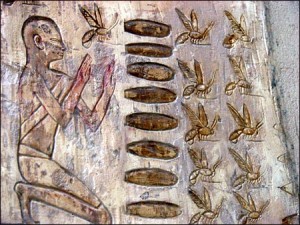
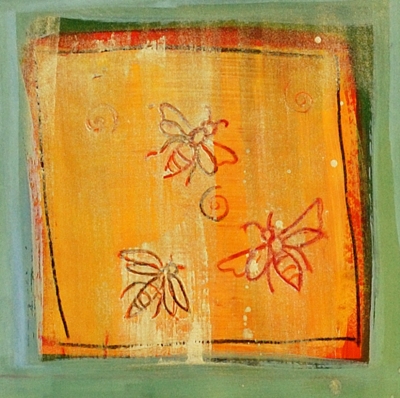
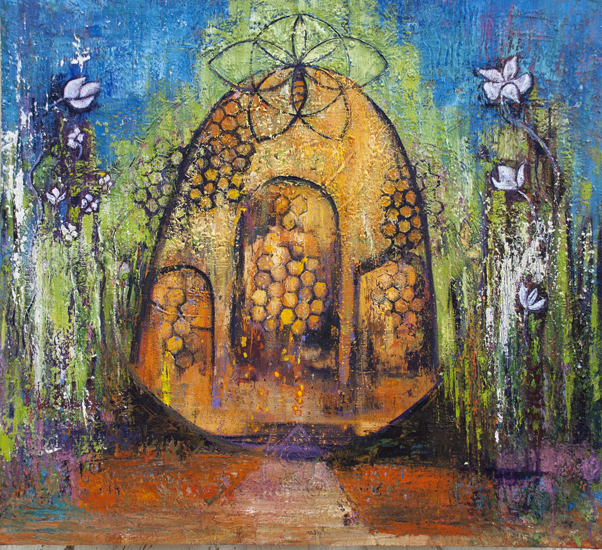
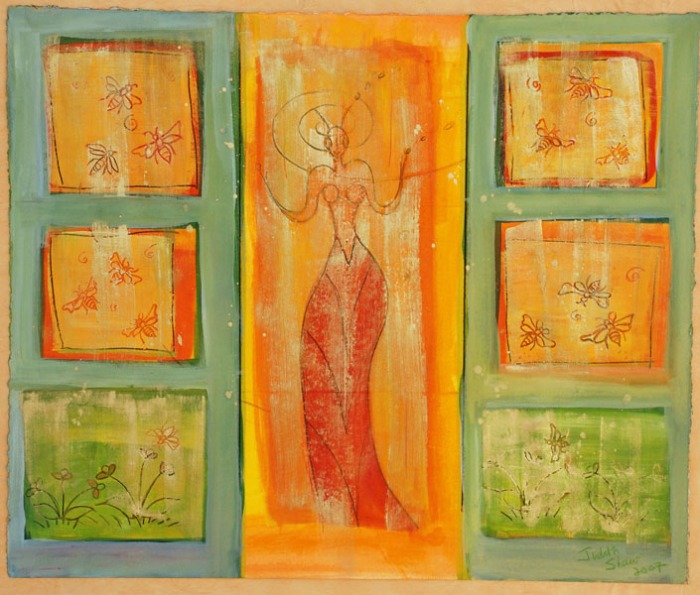
More info on the worship of Bees http://andrewgough.co.uk/articles_bee1/
ReplyDeleteEthnobeeology https://vimeo.com/channels/ethnobeeology
ReplyDeleteThe Holy Bee https://vimeo.com/channels/ethnobeeology/58443543
ReplyDeleteSacred Tools of the Bee Priestess, Layne Redmond https://www.youtube.com/watch?v=65KyNjT7u40
ReplyDeleteWhat happens if all the Bees die? https://www.youtube.com/watch?v=JilYBVrFiLA
ReplyDeleteThe Waggle Dance!!! http://video.nationalgeographic.com/video/weirdest-bees-dance
ReplyDeleteCollege of Melissae Sacred Art of Bee Keeping http://www.collegeofthemelissae.com
ReplyDeleteFirst 3 Reads I will Read:
ReplyDelete1. The Song of Increase: Returning to Our Sacred Partnership with Honeybees Paperback – December 4, 2014
by Jacqueline Freeman
http://www.amazon.com/dp/194247900X/ref=wl_it_dp_o_pC_nS_ttl?_encoding=UTF8&colid=31ZRS8OTRZ6KC&coliid=I4XNBHYPFWKQ2
Provocative and trail-blazing, this book clarifies fundamental changes that can transform our relationship with bees into one of deep partnership. In her compelling interweave of personal story, unique "from the bees" communications, and her years of beekeeping experience, Jacqueline invites us into an even larger and imperative conversation we all must begin with each other and with bees so their long-term survival is ensured. Since 2010 the bees have been communicating with Jacqueline Freeman, a farmer and beekeeper in Washington state. Through words and images, the bees share a courageous view of their role on Earth, including their charge to help with the evolution of agriculture and humankind. They describe the matrix of their thought and imagination and their intent to assist humans in their spiritual evolution. Guided by the question "How can I help bees sing their song of increase?" Jacqueline committed to a more relational and non-intrusive way of working with her bees to create treatment-free health and contentment in the hives. In the book the bees explain why so many colonies are dying, and what we can do to reverse the collapse. They describe the higher role of drone bees ("the holiest of beings"), the importance of swarming, the crucial function of temperature and scent to the health of the hive and the infant bees, and the secret of the Queen's prolonged and robust fertility. The bees offer a profoundly deeper explanation of pollination and they describe how honeybees can help heal humans. If you keep bees or care about them, this wise book will help you start this necessary dialogue.
ReplyDelete2. The Sacred Bee in Ancient Times and Folklore (Dover Books on Anthropology and Folklore) Paperback – April 9, 2004
by Hilda M. Ransome
http://www.amazon.com/dp/048643494X/ref=wl_it_dp_o_pC_S_ttl?_encoding=UTF8&colid=31ZRS8OTRZ6KC&coliid=I2DX8ZPZHIF1X1
Hilda Ransome's well-documented and copiously illustrated study of bees points out that no creature has provided man with so much wholesome food; nor has any inspired so many beliefs and superstitions. Illustrations depict bees, hives, and beekeepers as they appear in paintings and sculpture, on coins, jewelry, and Mayan glyphs; and carved into African tree trunks. Chapters cover the folklore of bees and bee culture — from Egyptian, Babylonian, and other ancient sources to practices in modern Europe. The use of honey in religious rites, as well as customs and superstitions in France and Central Europe, folk stories from Finland, and the bee in America are also described.
3. Bless the Bees:: the Pending Extinction of our Pollinators and What We Can Do to Stop It Paperback – September 2, 2013
ReplyDeleteby Kenneth Eade
http://www.amazon.com/dp/1492794163/ref=wl_it_dp_o_pC_nS_ttl?_encoding=UTF8&colid=31ZRS8OTRZ6KC&coliid=I1HAOAFICHBOO
#1 Kindle Best Seller the first weekend of its publication. "This is a very important book and one that belongs in the hands of everyone who cares about ecology and the preservation of the bee population, and that in turn means the preservation of life as we know it on this planet." - Grady Harp, Amazon Hall of Fame Reviewer. Albert Einstein said, "If the bee disappears from the earth, man would have no more than four years to live." This beautifully illustrated edition is meant to educate the reader about the potential extinction of the bees as an indicator of a mass extinction, the last one of which was 65 million years ago. It explains what pollination is, who does it, why its essential to us, what things are threatening our pollinators and what we, as individuals, can do about it. They have been in existence for over 100 million years, but it has taken us less than 30 years to kill almost all of them off. Honey bees are responsible for pollinating 60% of the world's food supply. Without them, the human race would face starvation. A worldwide epidemic, it has been called the bee apocalypse by Russia's president, but it is worse in the United States than any other country. Since 1972, feral honey bees in the United States have declined 80% to near extinction, and domestic bees in the United States are down to 60%. Since 2006, the epidemic has been referred to as colony collapse disorder, describing the disappearance of entire colonies of bees. Among the causes cited for this disaster of epidemic proportions are parasites, the decrease in abundance and diversity of wildflowers, insecticides and genetically engineered foods (GMO's) that create their own synthetic pesticides which kill bees as well as other insects. But one thing is for certain-- mankind is responsible for the drastic decline in bee population and the United States government is doing nothing about it. On the contrary, the government has taken measures to make the problem worse. There is more to this delicate 100 million year old evolution of pollination that just honey bees, who were not native to the United States, but imported from Europe and probably originally came from Africa. At least 4,000 species of wild bees are known to exist in North America alone. All of them are at risk, and this book will show you how you can make a difference in saving them, our food supply, and our planet as we know it.
ReplyDeletehttps://www.omlet.us/guide/bees/about+bees/
http://www.scientificamerican.com/article/the-beguiling-history-of-bees-excerpt/
ReplyDeletehttp://en.m.wikipedia.org/wiki/Queen_bee
ReplyDeletehttp://www.thisiscolossal.com/2015/05/an-extraordinary-glimpse-into-the-first-21-days-of-a-bees-life-in-60-seconds/
ReplyDeleteAs the famous biologist E. O. Wilson said, ‘If all mankind were to disappear, the world would regenerate back to the rich state of equilibrium that existed ten thousand years ago. If insects were to vanish, the environment would collapse into chaos."
ReplyDeletehttp://realitysandwich.com/315765/ensconced-in-eros-bathed-in-beauty/
ReplyDeletehttp://www.mnn.com/your-home/organic-farming-gardening/blogs/burgeoning-bee-buffers-feed-hungry-honeybees Awesome news!!!
ReplyDeleteSuper Bees/ Building Bees http://ngm.nationalgeographic.com/2015/05/building-bees/mann-text
ReplyDeletehttps://www.facebook.com/SacredEcologyFilms/posts/780313185381243?hc_location=ufi
ReplyDeletehttp://phys.org/news/2007-03-decipher-bees.html
ReplyDeletehttp://www.beesource.com/point-of-view/
ReplyDeletehttp://biobees.blogspot.com/2011/02/10-lessons-we-can-learn-from-honeybees.html
ReplyDeletehttp://en.wikipedia.org/wiki/Telling_the_bees
ReplyDeleteJudy Collins Cook with Honey https://www.youtube.com/watch?v=crUfbSrNMv8
ReplyDeleteDid you know about the Queen Bee and Royal Jelly...they are all born as equals https://www.youtube.com/watch?v=ivqconjgahg
ReplyDeletehttp://www.scientificamerican.com/article/you-have-a-hive-mind/
ReplyDeleteAndrew Gough - Hour 1 - The Sacred Veneration of the Honeybee https://youtu.be/RAAUSyFpZUg
ReplyDeletehttp://www.amazon.com/The-Shamanic-Way-Bee-Practices/dp/1594771197
ReplyDeletehttp://www.reshafim.org.il/ad/egypt/timelines/topics/beekeeping.htm Ancient Egyptian Bee Keeping
ReplyDeletehttp://www.blogtalkradio.com/voicesofthesacredfeminine/2011/07/26/bee-priestesses-wmarguerite-rigoglioso
ReplyDeletehttp://youtu.be/_nph_qNzBus Wow what a Beautiful ritual for the Bees, the sacred Bee. I love the song and the spiral dance, moves just like when the workers are protecting the queen so Beautiful 🐝💛 Bee Love 🐝💛
ReplyDeleteAnother part of the ritual http://youtu.be/JU4XXPXwGUI
ReplyDeleteI have to decided to stop purchasing almonds, for two huge reasons. First, commercial bee keeping. Second, water consumption, it takes 1 gallon of water to produce one almond, they are produced in a drought stricken area. The bag on the counter will be my last bag I purchase. As you know already the Bees are disappearing of this planet, 1/3 of the food we eat are pollinated by Bees. California dominates almond production like Saudi Arabia wishes it dominated oil. More than 80 percent of the almonds consumed on Planet Earth hail from there. 70 percent of the state's output is exported—California's almond groves are expanding. The delicious nut's acreage grew 25 percent between 2006 and 2013. California almonds are a $6.5 billion dollar industry -- the most profitable crop in the state.
ReplyDelete1. I do not support commercial beekeeping of this kind, they use 1.6 million bee colonies and ship 1 million bee colonies to the almond fields every year to pollinate. 60 percent of the managed honeybees in the entire country are used for almonds. They put the bees on huge trucks and ship them across country. Millions of Bees die before even making it to California. It disrupts their natural way of being, stresses the colonies and affects them negatively. Please research colony collapse disorder. http://www.nytimes.com/2015/05/14/us/honeybees-mysterious-die-off-appears-to-worsen.html?_r=0
http://www.motherjones.com/tom-philpott/2014/04/california-almond-farms-blamed-honeybee-die
2. The water consumption in California. California's drought has sparked a controversy around one of the state's most popular crops: almonds. A recent study shows it takes one gallon of water to grow one single almond, sparking scrutiny during a time when water is in short supply.
http://www.cbsnews.com/news/almonds-a-tough-nut-to-water-under-pressure-in-california/
🐝💛 Bee Love 🐝💛
Amazing documentary Queen of The Sun http://www.queenofthesun.com
ReplyDeleteSedyanka tradition, bee ceremony http://bnr.bg/en/post/100114134/working-bee-songs
ReplyDeleteMelissae ensemble in bee ceremony above http://www.traditionalfun.org/melissae.html
ReplyDeletecute song :) https://soundcloud.com/sara-tone/honey-bee
ReplyDeleteList of crops pollinated by the Bees https://en.wikipedia.org/wiki/List_of_crop_plants_pollinated_by_bees
ReplyDeletehttp://www.buzzaboutbees.net/plants-for-bees.html
ReplyDeletehttp://www.ent.uga.edu/bees/pollination/plants-year-round-forage.html
ReplyDeletehttp://www.sciencedaily.com/releases/2015/06/150616114040.htm
ReplyDeletehttp://nymag.com/daily/intelligencer/2015/06/bees-are-literally-worrying-themselves-to-death.html
ReplyDelete(Reference for the animation part of the project) The Bee Movie, Inside details...http://entertainment.howstuffworks.com/bee-movie.htm
ReplyDeleteHoney Bee Ritual "Myth is the reality of the soul." http://youtu.be/G8hQnAeAgTs
ReplyDeleteHoneybee Collapse is the Result of Their Enslavement in Industrial Monocultures http://www.resilience.org/stories/2015-05-26/honeybee-collapse-is-the-result-of-their-enslavement-in-industrial-monocultures
ReplyDeleteHow Bees Benefit Other Living Things http://www.onegreenplanet.org/animalsandnature/how-bees-benefit-other-living-things/
ReplyDeleteNational Strategy to Promote the Health of
ReplyDeleteHoney Bees and Other Pollinators http://pollinator.org/fedhealthstrategy.htm
14 Things That Prove Bees Are Actually Superheroes http://www.buzzfeed.com/kellyoakes/14-things-that-prove-bees-are-actually-superheroes#.paN9Noeam
ReplyDeleteBee-friendly: World’s first ‘bumblebee highway’ opened in Norway http://rt.com/news/261525-bumblebee-oslo-highway-inaugurated/
ReplyDeletehttp://weddingtraditions.about.com/od/MarriageTraditions/fl/Quotes-and-Readings-for-a-Honey-Themed-Wedding.htm
ReplyDeleteFuture...school gardening http://www.permaculture.co.uk/videos/edible-schoolyard
ReplyDeletehttp://aperiodical.com/2015/01/apiological-mathematical-speculations-about-bees-part-1-honeycomb-geometry/
ReplyDeleteBee Unity Post http://aphroditecalling.blogspot.com/2015/06/bee-unity.html
ReplyDeletehttp://csglobe.com/harvard-study-proves-why-the-bees-are-all-disappearing/
ReplyDeleteHarvard study showing neonicotinoids effects on Bees and Winterization
ReplyDeletehttp://www.bulletinofinsectology.org/pdfarticles/vol67-2014-125-130lu.pdf
http://ngm.nationalgeographic.com/2015/05/building-bees/transport-map
ReplyDeleteBiomimcry http://www.inc.com/dayna-baumeister/what-can-nature-teach-us-about-social-innovation.html
ReplyDeletehttp://www.npr.org/sections/thesalt/2016/01/11/462391470/a-hardier-honeybee-that-fights-back-by-biting-back
ReplyDeleteGenetically Modifying the Bee...but they fight back! Not all Genetic Modifying Organisms are "bad." Shouldn't we look towards technology for solutions. It is how humans use technology is the problem, not the technology and science itself. We will find many solutions in the future, for things humans have done to the Earth. The only solution for pollution is technology, since you and I will not give up their cell phones, tvs, computers and
consumption. ;)